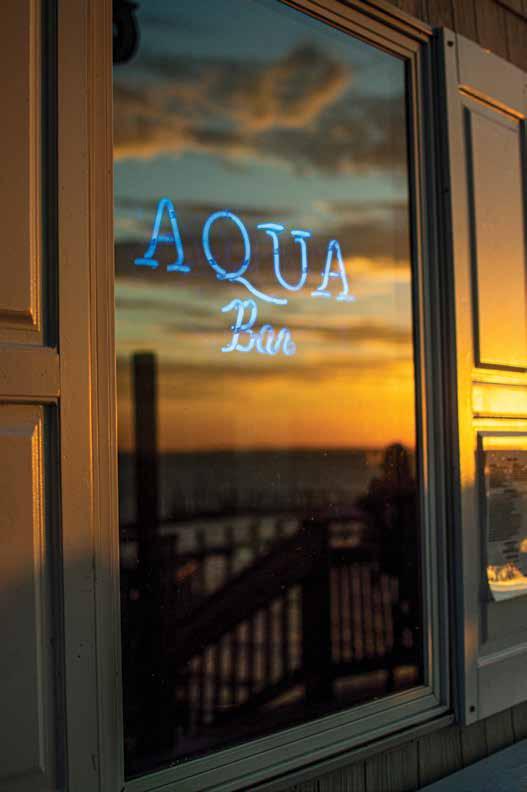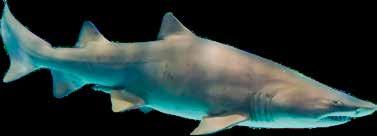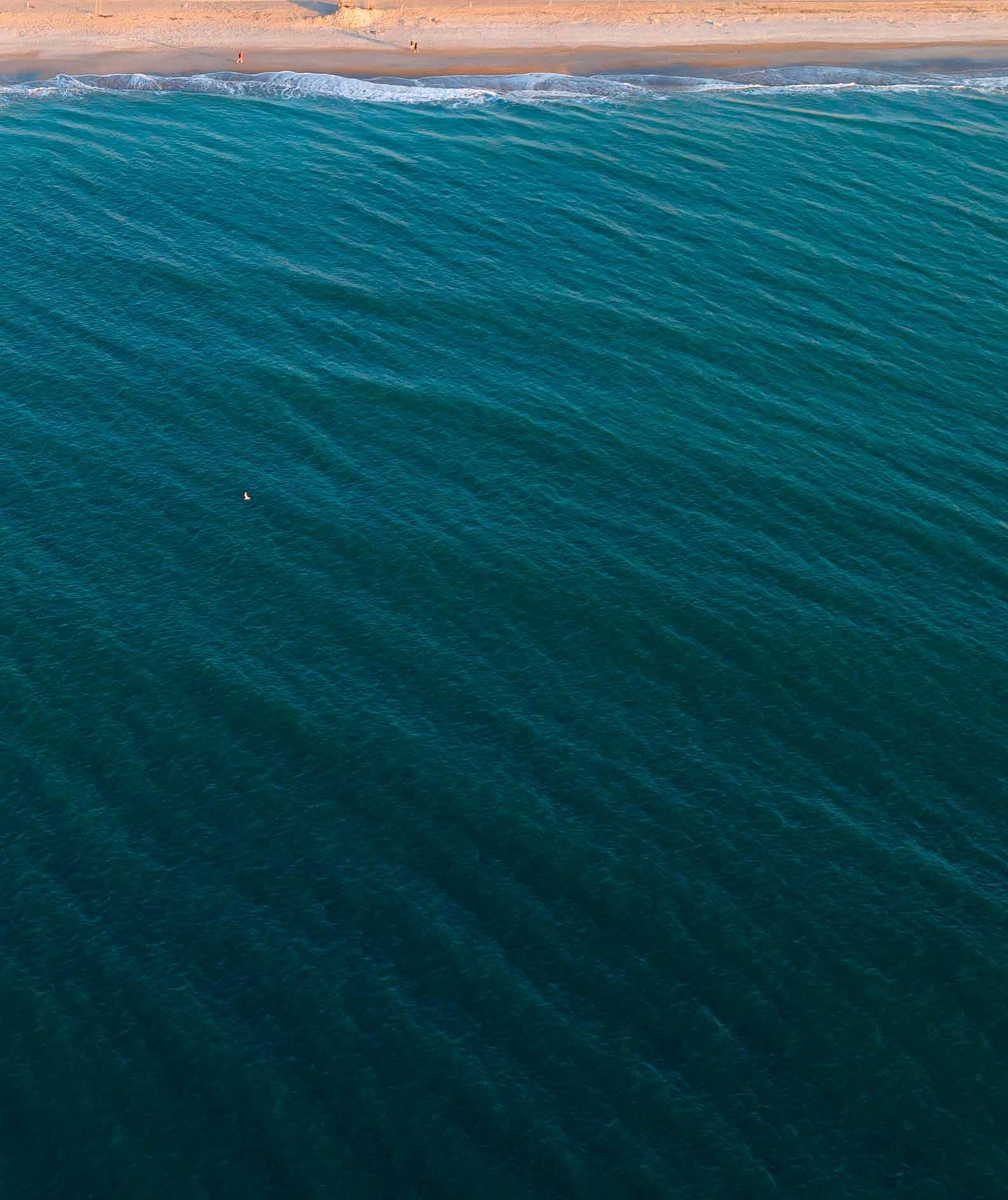Sculpt g Free! WINTER 2024

HOW FOUR LOCAL ARTISANS FOUND A COMMUNITY IN CLAY




Licensed
Certified
Licensed
Sewer





HOW FOUR LOCAL ARTISANS FOUND A COMMUNITY IN CLAY




Licensed
Certified
Licensed
Sewer






At the Outer Banks Visitors Bureau, we are committed to a future where tourism works in harmony with our community’s values. We want to ensure the area remains an incredible place to live and visit. As such, our focus on responsible growth views the work of the Visitors Bureau through a lens that considers both the positive and negative impacts of tourism. This commitment is embodied by the Long-Range Tourism Management Plan and by one of its early outputs – The Outer Banks Promise. This destination pledge fosters more conscientious behavior and a deepening respect and appreciation for the uniqueness of our community. If you haven’t already, we encourage you to make The Promise today. Small but impactful steps, when taken together, help to preserve and protect the Outer Banks for future generations.
The Outer Banks Visitors Bureau is proud to support the vital work of our local non-profits. In addition to meaningful collaboration and grant opportunities, we are also encouraging thoughtful visitation through our voluntourism initiative, resulting in a deeper appreciation for the area and a greater sense of responsibility.






As part of our goal to bring people deeper into the local culture and make them feel emotionally tied to this place, the Visitors Bureau created its first ever long-form YouTube Series, The Outer Edge. Each of the six episodes, the first of which will launch in January 2025, will feature dozens of OBX locals and celebrate their stories.












The Outer Banks is an amazing natural wonder that has been the source of historic achievements and supported a special way of life for generations. Let’s keep it that way and do our part. Look out for one another, be aware and prepared for any situation and work together to protect this place that we love. So let’s promise to:





















15 IN THE DETAILS
The works of artist Michael Riggs
20 FOUR IF BY SEA
I love this (sand)bar
22 SPEED FREAKS
Drag racing in Hertford
26 A SEASON FOR SQUASH
Three elevated dishes featuring common gourds
32 A BUILDER OF TOMORROWS
Reginald Fessenden's historic broadcasts
34 A COMMUNITY IN CLAY
Four artisans who share a passion for ceramics 42 DESIGN SNAPSHOT
A freshly updated home in Martin's Point
THE TIDES
New technologies for studying our waters 50 ISLAND STYLE
Go inside Rodanthe's new boutique hotel
58 FIVE FACTS
The Elizabeth II


THERE’S A PARTICULAR SORT OF DILEMMA that comes with writing anything down that’s meant to be read and understood by others: knowing where, and how, to start.
Do you take it from the beginning straight to the point, or cut directly to the end and wind your way back through the unfolding? There may even be some central mid-scene moment that briefly illuminates either side – like a flare shooting up in the darkness to show you, and your readers, where you’re going and where you’ve been, even if you’re not quite sure yet how you’ll navigate between the two, or at what spot exactly you’ll wind up.
The point is that writing is just as often about exploration as it is communication. Unlike, say, a physics experiment with its hypotheses and vital instruments, there’s no one right way to tell a story. Writers often see glittering possibilities, reach for them, maybe fail, try again, and then fail better, as playwright Samuel Beckett would say.
There are plenty of places we can go for clear, concise and pertinent information. Television stations and apps can give us all the latest traffic updates or tell us when it’s wise to take along a raincoat when we set off to run some errands. Pamphlets and maps outline mission statements or convey deadline requirements and codify spaces into manageable sets of type with little or no frills to distract or lose yourself in wonder.
There’s an orderliness to those types of things, like bullet points. The facts, and just the facts, like you might see in a law brief that winnows out emotional complexities to lay bare a precise scenario with cause and effect underlined alongside certain precedents for reaching one hard-and-fast solution.
Storytelling is a different beast altogether.
When we allow ourselves to tell stories, both factual and fictional, we open our minds up to different worlds and ideas. And, perhaps most importantly, we’re required to embrace complexities, to see how getting from point A to B can sometimes involve taking a side route past Z and Y.
This isn’t to say that we should always exalt, or even prioritize, one method of passing along information as opposed to all others in every situation – far from it, actually. Knowing what the weather might bring and where we should go to get a driver’s license renewed or apply for a job posting and extend our health insurance policies are all important things, too.
But if we want to get to the heart of some matter that interests us or learn more about something we never even knew was possible, storytelling has a distinct knack for being able to zoom in and out of spaces that are otherwise difficult to reach, allowing us access to thoughts and dreams, hopes and aspirations, and all that other minutia that makes us undeniably human, and, well, complicated
While we’re not fiction writers here at the Sun, we are all storytellers – and our aim within these pages is to take a journey with you, our readers, to see what we might yet discover about ourselves and our vibrantly interwoven community. We’re certain there’s still a lot left out there to explore.
As always, we hope you enjoy this issue!
PUBLISHERS
Adam & Cathy Baldwin
EDITOR
Editor Publisher
PUBLISHERS
Amelia Boldaji
Adam & Cathy Baldwin
ART DIRECTOR
Dave Rollins
EDITOR
Amelia Boldaji
WRITERS
Cathy Baldwin
ART DIRECTOR
Dave Rollins
Emmy Benton
Amelia Boldaji
CONTRIBUTORS
Steve Hanf
Catherine Kozak
Cathy Baldwin
Jessica Manack
Emmy Benton
Amelia Boldaji
Amanda McDanel
Cory Godwin
PHOTOGRAPHERS
Steve Hanf
Cory Godwin
Catherine Kozak
Brooke Mayo
Jessica Manack
Ryan Moser
Ryan Moser
Elizabeth Neal
Elizabeth Neal
Outer Banks History Center
Outer Banks History Center
Wes Snyder
Wes Snyder
SALES MANAGER
Helen Furr
Helen Furr
ACCOUNT EXECUTIVE
Faith Turek
DISTRIBUTOR
Clint Trice
The North Beach Sun is published quarterly by Access Media Group. All works contained herein are the property of the North Beach Sun
The North Beach Sun is published quarterly by Access Media Group. All works contained herein are the property of the North Beach Sun
The views expressed in the articles contained herein do not necessarily reflect the views of the publisher, editor or Access Media Group. The published material, advertisements, editorials and all other content is published in good faith. Access Media Group and North Beach Sun cannot guarantee and accepts no liability for any loss or damage of any kind caused by errors, omissions or the accuracy of claims made by advertisers.
NORTH BEACH SUN
The views expressed in the articles contained herein do not necessarily reflect the views of the publisher, editor or Access Media Group. The published material, advertisements, editorials and all other content is published in good faith. Access Media Group and North Beach Sun cannot guarantee and accepts no liability for any loss or damage of any kind caused by errors, omissions or the accuracy of claims made by advertisers.
115 West Meadowlark St.
Kill Devil Hills, NC 27948
NORTH BEACH SUN
252.449.4444
115 West Meadowlark St.
Kill Devil Hills, NC 27948
editor@northbeachsun.com
252.449.4444
editor@northbeachsun.com














































IN THE SUMMER OF 1937, the inaugural season of The Lost Colony drew throngs of people – but no evening was busier that season than August 18th when President Franklin Roosevelt appeared onstage at Waterside Theatre to give a speech prior to the performance.
The nationally broadcast spectacle was timed to coincide with the 350th anniversary of Virginia Dare’s birth on Roanoke Island, and it required a level of security that had never been seen before in Dare County. Luckily, it went off without a hitch – but that might have been, at least in part, because certain rogue elements were focused on other things. According to local lore, large-scale East Lake-area bootleggers took full advantage of that evening’s presidential diversion in order to evade the law by moving a recordlevel shipment of contraband moonshine across state lines during the play’s two-hour run.
THOUGH THE 18TH AMENDMENT banning the manufacture, transportation and sale of alcohol didn’t go into nationwide effect until 1920, North Carolina jumped the gun by enacting a similar statewide referendum more than 10 years earlier on May 26, 1908. With a majority ruling of 62%, NC became the first southern state to prohibit alcohol, and the first state in the nation to do so by popular vote.
But it didn’t end there. Nationwide Prohibition was repealed in 1933 with the passage of the 21st Amendment, but NC stood its ground for another four years until state legislature finally ratified the reversal in 1937. Even with that, it was another four decades before NC formally passed a law allowing individual counties and municipalities to decide if they wanted to approve selling liquor by the drink in 1978 – and manufacturing liquor was still strictly banned in NC until 1979.
In Dare County, the option to sell mixed beverages was authorized in 1980 – but not all the towns were onboard. While many were fine with establishments serving beer and wine, Southern Shores held out on approving liquor by the drink until 2005, and the town of Manteo resisted authorizing similar sales until 2011.
THE PROCESS OF AGING alcoholic beverages has been around for centuries, but downtown Manteo’s NouVines is one of a select few local watering holes that can trace the lineage of both their house reds and their décor.
Tucked inside the venue’s brick exterior is a fairly unassuming wooden bar that originally graced the lobby of Buffalo City’s sole hotel, the Red Onion, on mainland Dare County’s westernmost point. As a premier logging town turned bootlegging hotspot in the late 1800s and early 1900s, Buffalo City’s illicit operations were significant enough that they attracted the attentions of organized crime members like Al “Scarface” Capone, who reportedly made around $27 million a year on
moonshine sales alone during the height of nationwide Prohibition – and, according to descendants of Buffalo City residents, eventually acquired the Red Onion’s bar in order to install it on one of his private boats.
The mirrored bar was returned to the Outer Banks by the 1940s, however, where it initially found a home in a Manns Harbor general store called Polly’s before becoming a centerpiece in Manteo’s famed Green Dolphin Pub during the ‘80s – and was eventually relegated to storage until NouVines opened its doors in the summer of 2021.
The Outer Banks is always full of fun things to do! Some of the following events were still being modified or added as of press time, so please check individual websites for the most current information.
November 22 – December 28 (selected dates)
Stroll through an illuminated winter wonderland at The Elizabethan Gardens this holiday season. Check the website for dates and times. elizabethangardens.org
November 24; December 1, 15
Shop local during these annual holiday markets at The Soundside event site in Nags Head. soundsidemarket.com
November 26; December 7, 17
Browse homegrown, home-baked and handmade items during this holiday market at Aviation Park. kdhnc.com
November 26 – December 31
Enjoy festive events, food and drinks while supporting families in need, with proceeds benefiting the Outer Banks Relief Foundation. misfitsobx.com
ANNUAL CHRISTMAS CRAFT VILLAGE
November 29
Kick off the holidays at this craft market in beautiful Historic Corolla Park. visitcurrituck.com
November 29 – December 21 (Fridays and Saturdays)
Step back in time to the 1920s during this tour of the lushly decorated Whalehead mansion. Enjoy Christmas carols around the Steinway piano and holiday treats at the conclusion of the tour. visitcurrituck.com
12 BARS OF CHRISTMAS
November 29 – December 31
Start a new Outer Banks tradition by visiting these 12 festive pop-up bars that are fully decked out in holiday cheer. 12barsofchristmas.com
WITH SANTA & KITES WITH LIGHTS
November 29 – 30
Take the kids by Kitty Hawk Kites across from Jockey’s Ridge in Nags Head on Friday or Saturday for pictures with Saint Nick. While you’re there, watch the night sky light up on Saturday as enormous kites with festive lights soar above the dunes. kittyhawk.com
COROLLA VILLAGE CHRISTMAS
November 29 – December 21 (Fridays and Saturdays)
Historic Corolla Village transforms into a wonderland that delivers holiday season spirit. visitcurrituck.com
CURRISHUCK OYSTER FESTIVAL
November 30
Enjoy all-you-can eat steamed oysters, steamed crabs, local beer, wine and live music from 11:30 a.m. – 4:30 p.m. at Sanctuary Vineyards in Jarvisburg. sanctuaryvineyards.com
November 30; December 5, 14
Stock up on locally made Christmas gifts at this holiday market in Nags Head. Check the website for times. nagsheadnc.gov/dowdyparkevents
CHRISTMAS IN DOWNTOWN MANTEO
December 6 – 7
On Friday evening, watch the Grand Illumination in front of the historic Manteo courthouse, and then enjoy the Christmas parade through downtown Manteo on Saturday. townofmanteo.com
CHRISTMAS ON THE NORTH END
December 6 – 7
On the first Friday and Saturday in December, costumed interpreters at Island Farm will share how Roanoke Island families celebrated the Christmas holiday in the mid-1800s. Guests will enjoy sweet treats, crafts and a visit from St. Nicholas. obcinc.org
December 6 – 8
This encore session of the Wings over Water Festival focuses primarily on migratory birds and waterfowl. wingsoverwater.org
December 7
Gather at the Duck Town Park for holiday music provided by Sam on Sax and the First Flight High School Choir, the lighting of the Crab Pot Tree, and the arrival of Santa Claus himself. townofduck.com
YES, VIRGINIA, THERE IS A SANTA CLAUS PRESENTED BY THEATRE OF DARE
December 7 – 8, 12 – 15
This heart-warming radio drama about a young girl’s letter to the newspaper is sure to bring Christmas cheer. theatreofdareobx.com
December 17
This aeronautical milestone will be celebrated at the Wright Brothers National Memorial, the same place that first flight history was made. firstflight.org
December 31
Celebrate New Year’s Eve family-style in downtown Manteo with fireworks, live music and children’s activities. manteonc.gov
& EXPO
January 18 – 19
Meet local wedding professionals, take a tour of venues and restaurants, and register to win wedding giveaways at this expo. obxwa.com
January 25; February 22; March 29; April 26
Enjoy live bluegrass music in the intimate indoor theater at Roanoke Island Festival Park on selected dates throughout the winter and early spring. bluegrassisland.com
NEW YORK, NEW YORK DUELING PIANOS: A NIGHT OF HARMONY AND GIVING
January 31
Sip on delightful cocktails and sample hors d’oeuvres while singing and dancing to the musically gifted New York, New York Dueling Pianos, all to raise money for the Dare Education Foundation. dareeducationfoundation.org
CAMELLIA TOURS
Tuesdays, Thursdays and Saturdays in February
Discover the fascinating world of camellia plants with this 45-minute camellia garden tour in The Elizabethan Gardens. elizabethangardens.org
RUNNING OF THE LEPRECHAUNS
March 15
Kick off St. Patrick’s Day festivities with this annual 5k and 10k race in Nags Head. obxse.com
TASTE OF THE BEACH
April 4 – 6
Eat and drink your way through the Outer Banks by taking part in any number of delicious Taste of the Beach foodie events. Check out the website for the event schedule and tickets. obxtasteofthebeach.com
FLYING PIRATE HALF MARATHON & FIRST FLIGHT 5K
April 11 – 13
Run 13.1 miles through the Outer Banks on this fun, pirate-themed half marathon that culminates with a Pirate Jamboree in Nags Head. obxse.com
LOST COLONY WINE FESTIVAL
April 12
Sip, savor and support The Lost Colony during this wine festival at the Waterside Theatre on Roanoke Island. tlcwinefest.com











Experience the Resort Realty difference and receive an OwnerCentric™, dedicated staff in local offices. Resort homes are assigned to individual property managers so you get a more personal touch from people who know you and your home! We offer no cost in-house
maintenance, a housekeeping department that truly cares, accompanied by unsurpassed in-house marketing. For KDH and points north, text or call Debbie Harrell at (252) 305-9011 or for Nags Head and Hatteras Island, text or call Lisa Nicholson at (252) 255-3569 to learn more!





How a local artist turned his passion into his life's work.
PHOTOS BY CORY GODWIN
STORY BY JESSICA MANACK

MANY CHILDREN TRY THEIR HAND at art by drawing familiar characters they’ve seen in comics or on television. Kitty Hawk resident Michael Riggs vividly remembers being a part of that tradition in elementary school when he carefully produced a sketch of Goofy. He was thrilled when his teacher recognized it as skilled and hung it on the bulletin board. What he didn’t anticipate was seeing his teacher on the front doorstep of his childhood home – “like the doctor would come to your house,” he recalls – when she arrived to tell his parents that his artistic abilities were extraordinary for his age.
Not long afterwards, Michael spent a summer studying with a neighborhood artist to refine his skills in a number of artistic techniques. He hasn’t stopped creating since.
Originally from the Virginia Beach area, Michael moved to the Outer Banks in 1986 at a time when the local year-round population was less than half of what it is today. Fascinated by the wide-open spaces, the diverse wildlife and the myths and legends surrounding his new


home, Michael discovered a near-endless supply of inspiration just outside his window.
From pen-and-ink drawings to watercolors, Michael began trying to capture the beauty and mystique of the Outer Banks in a way that celebrated his keen attention to detail while also invoking romanticism – and even a dash of mystery. Depicting anything from lighthouses, including those at Ocracoke, Currituck Beach and Cape Hatteras, to animal life like kingfishers and the northern beaches’ wild horses, his collected works have grown slowly but surely over the years.
Michael’s artwork now resides in many places, from the homes of those who live in the Outer Banks and beyond, to the collections of former senators and presidents. One of his most treasured possessions is a 1989 letter from President George H. W. Bush – who once visited the Outer Banks for anniversary festivities honoring the Wright brothers – thanking Michael for his work and saying that one of Michael’s paintings had been added to the holdings at the George H.W Bush Presidential Library & Museum on the campus of Texas A&M University.
Michael often makes prints of his artwork, keeping the originals, which can take up to 100 hours to produce. Working in pen-and-ink, he uses fine lines and effects like pointillism – a technique that involves applying a series of tiny dots in intricate















patterns – to evoke the tranquil grandeur of our coastal region. Recently, however, he’s also found himself drawn to a form he first tried decades ago – wood carving.
“I could do this for the rest of my days,” he says about his enthusiasm for bringing dramatic scenes of coastal animals to life. After sourcing fine woods ranging from spruce to more exotic specimens such as Honduran mahogany, he heads to his garage studio most days before the sun’s risen to shape the raw material into its final form with chisels and sandpaper.
“I get lost in my world,” Michael explains. “Once I’m in my studio, that’s where I can always be found.”
Experimenting in this medium is rewarding, even if it means he’s putting less finished work into the world these days. Each piece can take months to complete, and it can be hard to price them in a way that respects the time he’s invested in them – but those who do have his works in their home can appreciate their rarity.
Precision is especially important to Michael, who attends waterfowl shows and collects books to serve as reference points for his creations. Currently working on the profile of an osprey, he walks through the stages of his initial process: “I have to do a lot of research to pull it off. Is this a young osprey, where the eye color will change? You also have to think about the color of the feathers, which also change as they get older. That’s what I concentrate on, getting it right.
“That’s one of the smallest, but very important lessons,” he adds. “If you can understand what you are seeing, you can be a good artist.”

RÉPONDEZ S’IL VOUS PLAIT. This familiar French phrase indicates that a formal invitation has been extended to you, and that – according to Emily Post – you should let the host know whether you’ll be attending said event within a day or so of receiving the invite – or by any noted deadline at the very least.
For most of the 20th century, Emily Post was THE gold standard for etiquette after she released her first definitive guide to good manners in 1922. Unfortunately, like most things from the previous century, both Emily Post and the practice of promptly responding to an RSVP have fallen out of favor.
The lingering two-martini lunch with delicately placed cloth napkins has been replaced with combo meals that are hurriedly eaten while rushing from one meeting/ Zoom call/productivity report to another in an effort to squeeze every ounce of blood from today’s stone of “busyness.” Invitations to dinner parties are shelved to consult kids’ sports practice schedules and friendly fantasy football soirées, or simply put on pause until dashing off a quick “see you tonight” text three hours before the soufflé is due out of the oven.
Sadly, being overwhelmed by to-do lists has become standard practice for many – and bending our schedules up in knots to accommodate all the needs of any one family unit often results in a jumble of missed meet-ups and perpetual postponements.
There is, however, a standing invitation that’s open every night on the Outer Banks. One that does not bend and demands no official organizers. It is unspoken, yet those who pay attention will hear its call – while those who miss it do so sadly, and with regret. In short, it’s a
local event that I invite you to attend just to see it for yourself.
It might be tempting to think that this will require a trip to the oceanfront – particularly during the months of fall and early winter when the crowds thin, yet the weather tends to remain somewhat balmy, and the setting sun casts cotton-candy skies out across the Atlantic. This is where you’ll see photographers capturing golden-hour magic throughout the dunes and groups of surfers paddling into rippling waves for a quick afterwork session.
As if drawn by an informal drum circle – except without any circles or any drums –residents wind their ways down numerous side streets to the sound along Bay Drive.
As idyllic as this might appear, the real community action can be found on the western edge of the Outer Banks, where you’re sure to encounter plenty of familiar faces flocking toward the water while towing wagons full of busy toddlers or walking side-by-side with a variety of wiggly fur butts. As if drawn by an informal drum circle – except without any circles or any drums – residents wind their ways down numerous side streets to the sound along Bay Drive.
Starting around September, Mother Nature can be counted upon for a near-nightly show of pink and yellow that begins about 30 minutes before the sun hits the water when the sky is painted with fading brushstrokes of color. By the time she really ramps up these public displays in October, those who make that evening trek west are greeted with a growing impromptu social hour along the sound.
By Amanda McDanel
Once there, you’ll find bikers and boomers alike sharing conversation and camaraderie, three-wheel riders passing out treats to tail-wagging pups, influencers struggling to catch the perfect lighting for a #selfie, and out-of-state couples seeking rum bar recommendations from jovial year-round residents. Glowing hula hoops spin, swings occupy large oak trees, and beverages are passed around companionably with minimal fanfare –creating a scene that would feel right at home in a music video for country singer Toby Keith’s “I Love This Bar.” It’s a transformational time that can make the world feel comfortably small, neighborly and hopeful. Transplant community members catch up on the current plight of Hokie football and commiserate over a shared longing for the eventual return of Beamer Ball, while a barista from a nearby coffee shop regales her regulars with a list of their latest cool-season offerings. As a hairdresser bikes past she calls out to a customer, “Your color turned out so good!” Offers of fresh fish, an abundance of figs, and very late summer tomatoes are exchanged.
At their best, these gatherings remind us how beautiful and simple this life can be. For when we set aside politics, divisiveness and the raging sounds of the outside world, we are reminded of the beauty, the bounty and the breathtaking grace that’s directly in front of us. It’s right there outside our doors, just waiting for us each night, with an open invitation to come as you are… and with no RSVP necessary.





















By Steve Hanf
Black smoke drifts in the air as vehicles pull up to the starting line. Engines rev. A scent of burning rubber occasionally mixes with columns of billowing exhaust fumes. The light flashes green. Several trucks tear down the straightaway while the crowd roars, and the next set of competitors idle into formation.
Twice each year, an estimated 2,000 spectators make their way to Hertford, North Carolina, to watch about 100 high-speed hopefuls compete in the Diesel Truck Wars. After officially starting their engines nearly 10 years ago in 2015, this uniquely popular drag racing event is the brainchild of Chris Parker of Virginia Beach and his longtime friend Buddy Callaway, a Wanchese native who still calls Dare County home.
“We got started because we raced diesel trucks, and we didn’t have a local event to race at,” Buddy explains. “These are events that we say are, ‘For the racers, by the racers.’”
The days’ activities start in sunshine and end under the bright lights of the Northeast Dragway’s 1/8th-mile track. Nestled in the fields of Hertford County about halfway between Edenton and Elizabeth City, it can be a bit of a trek for some, but it’s certainly worth it for the enthusiasts who gather there biannually every March and October.
“The success of these events are highly determined by the number of racers, the number of sponsors and the number of spectators,” Buddy says of the Wars’ shoulder-season timing that intentionally avoids upstaging fellow competitions held at the Hertford drag strip. “We learned early on that it’s pretty common sense to respect other event promoters.”
Wars’ drivers come for their need for speed, and sponsors love that it’s the only event of its kind in northeastern North Carolina since virtually any licensed driver can compete. For spectators, there’s also a festive atmosphere that includes an array of sponsor tents, a truck show, food vendors and plenty of head-turning runs down the 660-foot straightaway.
The Diesel Truck Wars welcomes anything that’s diesel powered, according to Buddy, which means that some modified sedans and even a few sport utility vehicles will show up for a run every now and then. But the event’s main focus is on diesel trucks in five different classifications.
At their most recent October event, the marquee Outlaw class – headto-head racing in the fastest division – was won by Hunter Coffey, whose four-door Cummins-powered Dodge needed just 5.11 seconds to cover the full distance of the drag strip – that’s a speed of 145 miles per hour if you’re doing the math.



Two other race classifications showcase a little less speed. The 7.70 Index and 6.70 Index offer head-to-head racing that requires drivers to know their vehicles’ capabilities especially well: In the 7.70 Index, the driver can’t finish in less than 7.7 seconds or it’s an automatic loss. Ditto for the slightly faster 6.70 Index.
“It’s about getting as close to that time as you can,” Buddy says of the 7.70. “It’s a fast class – they do about 90 mph in 660 feet – and it’s really enjoyable.”
When it’s all said and done, trucks have gone flying down the Hertford drag strip as fast as 180 miles per hour, and upwards of $20,000 has been awarded to Wars’ winners over the years.
The 7.70s check in around 750 horsepower in an average diesel truck, while the 6.70s typically boast a few more upgrades to run around 100 miles per hour with about 1,000 horsepower. “It’s also a full second faster, which is a lot different in the seat of your pants, you know?” Buddy says of the latter classification. “It just feels a lot faster.”
The Elapsed Time (ET) bracket, on the other hand, is less about speed than it is about precision. In this class, drivers are invited to dial-in an estimated ET for their particular vehicle in order to determine any pre-race handicaps. If one car is even a second slower than the one it’s matched against, the slower vehicle gets the green light first, which helps ensure that the race hinges on both drivers’ reaction times and their accuracy since competitors are expected to stick as close to their dial-in time as possible.
“That’s a good entry-level class if you’re looking to get into drag racing,” Buddy explains. “It doesn’t matter how fast you go or what exactly you drive.

You have just as much chance of winning as anybody else with a good running vehicle.”
Another Singles Elite division highlights vehicles with a single turbocharged engine, so no twin turbos, and also no nitrous – criteria which tends to appeal most to experienced racers who love fine-tuning their setup to make everything work just right.
When it’s all said and done, trucks have gone flying down the Hertford drag strip as fast as 180 miles per hour, and upwards of $20,000 has been awarded to Wars’ winners over the years. Some of the event’s racers travel from as far away as Florida, California, Arizona, the Midwest and even Canada.
Other competitors are a bit more local to the Outer Banks area, including some of Diesel Truck Wars’ sponsors. There’s Kill Devil Diesel and Griffith Diesel Worx in Currituck County, plus Twisted Diesel of Chesapeake that often showcases trucks in the races. Kitty Hawk’s Albemarle Landscapes and Tree Services even sponsors the Wars’ ET bracket.
“Some of their customer trucks and their personal vehicles have been racing with us since the day we started,” Buddy says of the close relationship he and Chris have with their sponsors.
It’s fairly easy to see the appeal of drag racing to the mechanically minded, particularly because it embraces engineering know-how just as much as anything physical. Like so many others, Buddy and Chris got started in the sport because it held their interests and challenged them to keep pushing the envelope. “I bought a diesel truck, and I started messing with it to make it faster – and it got surprisingly faster than expected,” Buddy says with a laugh. “And then one thing just led to another.”
He likens the Diesel Truck Wars of today to the glory days of the 1960s

and ‘70s hotrods that numerous non-professional shadetree mechanics would tinker with in their spare time.
Drivers ready their engines for the green light in several different race classes offered during the Diesel Truck Wars (photo courtesy of Jenn Smith Photography).
“You’d buy a Chevrolet car with a big block, and it didn’t take much to make it the king of the road,” Buddy says. “Nowadays with diesel pickups and electronic tuning, you can just plug a computer in to your truck and next thing you know you’ve got 700 horsepower. They’re very easily modified.”
The relative ease of getting started is probably why these sorts of grassroots events have begun popping up from coast to coast, with racers seeking out more speed to vie for a piece of the prize purse and a few brag-worthy trophies – which can include custom merchandise like t-shirts featuring images of winning vehicles from previous events.
Outside of their homegrown event, Buddy and Chris have traveled as far as Indiana and Tennessee to compete in other races, but both have been somewhat parked this past year. Chris blew an engine that’s still in the process of being rebuilt, while Buddy recently sold his old truck to build a faster, lighter one. It’s clearly a topic that’s close to his heart as Buddy explains that his go-to is a General Motors Duramax V8, and that the fastest he’s gotten his four-wheel-drive diesel truck to go is a 5.71-second run at 123 miles per hour.
“You think about it: In 660 feet, if you’re doing 123 miles per hour, you’re going zero to 60 in less than a second. There’s a lot of g-force,” he says. “I don’t really care if it’s street legal; I just want to go as fast as I can.”



Your Outer Banks Community Foundation offers many ways for you to support causes that you care about in our community, like:
Affordable housing & healthcare for our hardworking people
Disaster recovery efforts
Child care for local families
Outer Banks history, culture and the arts
Our beaches, the environment and all animals

IT CAN BE HARD to beat a winter harvest filled with essential vitamins and other nutrients, but when it comes to picking the best cold-weather produce on the shelves, it’s what’s on the inside that counts most.

PUT A LITTLE HEART INTO IT! The biggest difference between squashes found in the winter verses the summer is their skins – warm-weather varieties like zucchini and yellow squash are harvested before they’re fully mature so their rinds are still tender, while other cool-season options like sweet pumpkins and butternut have tougher rinds that allow them to resist frosts and be stored for longer. But don’t let their steely exterior fool you – these gourds are good to the last bite once you get past their natural defenses. And whether you roast, bake, mash or puree them, they also pair exceptionally well with warm spices like cinnamon or ginger. Happy holidays, indeed.
Pictured here: Miso-braised and seared sweetheart cabbage on a bed of pureed ginger and butternut squash topped with wasabi microgreens.

TERRIFICALLY TENDER BOTH INSIDE AND OUT? For that you’ll want to keep your eyes peeled for one of the few exceptions to winter’s hard-rind squashes – namely, varieties like acorn, red kuri and delicata. While all winter squash skins are technically edible – particularly if you cook them long enough – the reality is that some simply taste a lot better than others. Your best bet in this deliciously versatile department is delicata, which lives up to its name with a colorful outer layer that practically melts in your mouth once it’s cooked. No extra peeling necessary.
Pictured here: A Mediterranean-inspired salad made up of roasted delicata squash, shaved Brussels sprouts and cracked rye berries tossed with a white balsamic-and-caraway vinaigrette and a handful of fresh pomegranate seeds.

THESE AREN’T YOUR AVERAGE NOODLES . If you’re carb-conscious or even just looking to cut some calories, there’s a squash for that! But be warned: Even among other members of the cool-season gourd family, spaghetti squash is especially thick-skinned, so you’ll want to have a sharp knife handy. Once you’ve managed to cut the squash in half widthwise, however, all that’s left to do is remove the seeds (which can also be toasted if you’re so inclined) and then roast it. When it’s out of the oven, you can easily scrape the flesh out of its shell with nothing more than a fork – and that’s amore.
Pictured here: A generous helping of shredded spaghetti squash served over a thin layer of tomato sauce and topped with a mix of sauteed baby kale, mustard greens and pan-roasted garlic slices.











Join us this winter with these fabulous town events: the Christmas Tree Lighting on December 6th, a Christmas parade on December 7th, and Meet Me in Manteo for New Year's Eve.
407 Budleigh Street 252-473-2133 info@manteonc.gov

We’re an independent bookstore - of course we know how to put the right book in the right hands at the right time! Books for all ages, the biggest selection of greeting cards on the Outer Banks, author events and more. Join the Hero Party! Meet Dogman a er the Christmas parade (Saturday 12 – 2 p.m.).
103 Sir Walter Raleigh Street 252-473-1056 ducksco age.com

Full-service ladies’ boutique specializing in fashions that are traditional with a contemporary flair. Seasonal makeup events with Trish McEvoy and designer trunk shows. Check website for details.
103A Fernando Street
252-473-3078
shopcharlo es.com
Take a walk down memory lane in this li le mom and pop sweet shop! Birthday parties, ice cream, throwback candies, chocolates, homemade co on candy, fun gummies, bulk candy and more!
101 Budleigh Street
252-473-2579
laughinglollipop.com
Like us on Facebook
Apparel for “Her” including sleepwear. We o er jewelry, handbags, Thymes fragrances, gi s and home textiles.
101B Fernando Street
252-475-1971
Like us on Facebook

Visit the 1587 Restaurant & Lounge, featuring locally sourced dishes that complement the breathtaking views of the bay, and enjoy all that downtown Manteo has to o er.
405 Queen Elizabeth Avenue
252-473-1404
tranquilhouseinn.com


A fashion-forward boutique o ering unique, high-quality women’s clothing and accessories. Pop in for an enjoyable, personalized shopping experience.
107 Fernando Street 252-305-8638 bloomboutiqueobx.com

As you enter the island, pop in and enjoy the Outer Banks’ premier gallery of fine art, fine cra , unique gi s, bonsai trees and home to our Modern Heirloom® goldsmithing studio. Celebrating 25 years.
905 US Hwy 64
252-475-1413 silverbonsai.com nest
Distinctive clothing by CP Shades, Frank & Eileen, Juliet Dunn, Wilt and other niche brands. Sophisticated accessories, jewelry and fragrances for you and your home.
Magnolia Lane
252-473-5141 nestobx.com

Untucked is the exclusive men's resort retailer on the Outer Banks, bringing fresh brands to traditional coastal a ire.
101 Budleigh Street, Suite E 252-423-3020

“Deck The Hulls” is our holiday pop-up bar located inside of Outer Banks Distilling. We will be serving Kill Devil Rum holiday inspired cocktails and snacks the whole month of December, so come by and get into the true “spirit” of the Outer Banks!
510 Budleigh Street 252-423-3011
outerbanksdistilling.com
A family-owned lifestyle shop featuring home and garden goods, fine art, books, jewelry, and high-design adornments for ladies, gentlemen, children, and pets.
108 Sir Walter Raleigh Street 252-475-9764
@shopsamandwinston



While the Wright brothers were learning how to fly in Kitty Hawk, another inventor was pioneering airborne technology in a slightly different way just a few miles south.
BY AMELIA BOLDAJI

MERE MONTHS AFTER THE WRIGHT BROTHERS arrived in Kitty Hawk for the first time, an unremarkable schooner towing a couple of 50-foot-long wooden posts docked on Roanoke Island. It was January 1901, and bitterly cold, as two lone passengers disembarked. One was suffering from a bout of seasickness endured on the turbulent journey from Cobb Island, Maryland, while the other – a slender ginger-haired gentleman who was carrying a large wheel of limburger cheese – appeared almost entirely unbothered.
Unlike his queasy companion, Reginald Aubrey Fessenden had only one concern on his mind: That the two wooden posts he had insisted on traveling with had also arrived unscathed. Officially the property of the U.S. Weather Bureau, those posts would be used to establish two tall towers – one on the northwestern edge of Roanoke Island, and the other on the Hatteras Island village of Buxton – so that Fessenden could conduct field experiments in the futuristic new world of wireless telegraphy.
Fiercely intelligent and quick-tempered Fessenden wasn’t the only one racing to stake a claim in that emerging technology, however. Italian inventor Guglielmo Marconi had already developed a radio wave-based wireless telegraph system by 1895, and experiments intended to take those principals beyond dot and dash Morse code transmissions were well underway all around the world. The U.S. Weather Bureau, in particular, was interested in the potential for improving communications with ships far out at sea – which was why they offered Fessenden an impressive salary and near-unlimited financial backing to relocate to the Outer Banks and continue improving his wireless inventions.
It was an exciting prospect for Fessenden, who was a former teacher and headmaster before becoming a laboratory technician under Thomas Edison, and he had earned the promotion by being the first person in history to transmit his voice between
two wireless towers in Maryland just a month earlier in December 1900. With the Weather Bureau’s full support, his innovative breakthroughs only increased on the Outer Banks, and a little more than a year later he contacted his patent attorney to report good news:
“I have sent varying musical notes from Hatteras and received them here [on Roanoke Island],” Fessenden wrote in an April 1902 letter. “They were very loud and plain, i.e., as loud as in any ordinary telephone…the new receiver is a wonder!”
Unfortunately, circumstances unraveled from there. Suitably impressed with the advancements Fessenden was making, Weather Bureau officials decided that they should have a share in the revolutionary patents for Fessenden’s work. Fessenden staunchly refused, and his contract with the government was terminated in August of 1902.
Although he subsequently left the Outer Banks for good, that wasn’t even close to the end of Fessenden’s career – or his groundbreaking experiments in furthering wireless technology. Instead, Fessenden moved his family to Brant Rock, Massachusetts, where he continued working on promising attempts to establish reliable two-way transatlantic radio transmissions.
While some controversy exists over whether or not Fessenden was truly the first person to transmit a live entertainment broadcast over radio waves, the internationally respected inventor would still remember – decades later, in a letter to a friend written shortly before his death in 1932 – picking up his violin on Christmas Eve in 1906. That night, under a blanket of stars, Fessenden played a hauntingly slow rendition of Adolphe Adam’s “O Holy Night” into the transmitter at Brant Rock, letting the strains drift and swell out across the Atlantic Seaboard to be heard by any passing sailors who might have paused – even briefly, just for a moment – to close their eyes and listen.




















PHOTOS
BY
RYAN MOSER
COMPILED BY
JESSICA MANACK

ON A COOL OUTER BANKS EVENING, items to the fire, like gifts or offerings: a shallow bowl, some mugs and miniature vases, an experimental trinket or two. Their process is methodical, but not hurried. As potters with their own individual businesses, these four women – Melanie LaFountaine, Genevieve Stewart, Lauren Evans and Skyla Lamberto-Egan – know the steps of their craft by heart, but on nights when they set aside their electrical kilns and gather to experiment with pit firing their work, they are more than just artists. They are friends sharing space, swapping snacks and techniques as they talk about their lives and their current creative projects. They are a community.
Though they all came to ceramics for different reasons – and at different stages of their lives – the majority of them met on the Dare County campus of the College of the Albemarle in a continuing education pottery class taught by artist Robin York, who was also Melanie’s art teacher at Manteo High School. In the years since, they’ve each refined their practices, both together and apart, as they’ve all continued to appreciate the particular benefits and challenges of their chosen medium.
It’s a simple thing to watch them laugh and tell stories – sometimes even finishing each other’s sentences – as though their conversations are shaped like clay being formed and reformed, producing something new each time. At the center of their circle, the bonfire grows and peaks before slowly dying down. Now it’s time to retrieve their glittering packages, and examine the effects of what they’ve forged.




Melanie LaFountaine was always destined to be creative, but it took her a bit of time to accept that fate. After dabbling in a number of different artistic mediums, she earned a bachelor’s degree in photography before returning to her Outer Banks hometown where working several other jobs made her realize that pottery was her one true passion.
“My parents finally had to sit me down and say, ‘You need to focus on ceramics,’” she recalls with a laugh. It wasn’t lost on them that orders for her stylistic pieces had been steadily increasing from the very start, and Swell Ceramics was born.
For Melanie, one of the most rewarding – and also frustrating – parts of working with clay is that it’s not always possible to control how a glaze will look after it’s been fired. One of her most popular finishes is a glaze she calls “Morning Wash” because it reminds her of early summer mornings walking her dog on the beach. Initially created as a happy accident in her studio, she went through several trial recipes before she figured out a way to reliably recreate it.
“Pottery is chemistry,” Melanie explains. “It’s so particular, and so much can go wrong, but there’s also a million different things you can do with it – and if you get bored, you can always try something else. I like that type of challenge.”
Originally from Pittsburgh, Lauren Evans initially conceived of Wana World Market as a way to feature handmade goods she discovered while traveling around the globe. “I had teachers who wanted to point me to trade school, which wasn’t such a popular option in the late ‘90s,” she explains of her journey. “I worked in restaurants, and as a designer for a construction company…I’ve done a lot of things.”
Realizing that she had to figure out her own path, Lauren has since created a robust retail and wholesale business of small colorful pieces that include surfboard ornaments and pocket-sized magnetic bud vases. With a steady demand for these offerings in her repertoire, she has the opportunity to make many versions of the same models via different glazes and finishes in order to keep things fresh.
“Sometimes I’ll try new things, and, if the response is good, I’ll make more,” Lauren says of items such as her pinch-pot ring dishes, which incorporate bits of locally found sea glass. Once they’ve been fired in extreme heat, the bits of colored glass melt and blend together in an array of shades as unique as each sunset.
“My mom and dad owned their own business, so I learned a lot from them,” Lauren adds. “I think that’s what made me stay in the Outer Banks after vacationing here over the years – that entrepreneurial spirit.”












It’s perhaps unsurprising that Genevieve Stewart of Soundside Road Pottery started out as a photographer, honing her precise eye for capturing tiny details that others might easily miss. While raising her two young daughters, she also grew a bustling Outer Banks wedding videography and photography business, but after more than a decade in that field, she felt an urge to do something new and personally satisfying.
Finding that outlet in pottery, Genevieve now tends to finish her pieces with a decorative technique called sgraffito, which comes from an Italian word that means “to scratch” because it involves chiseling away bits of a work’s surface layer to reveal an underlying base.
“I’m inspired by nature, the ocean, animals, the moon – both of my daughters were born on full moons,” Genevieve explains of the basis for her distinctively themed artwork.
“With glazes, you don’t get to see what the finish is going to look like before it’s fired, which was baffling to me at first. I was looking for more control, asking myself, ‘Why am I not doing something with the surface?’
“Overall, I’m a creative person, and that is a necessity to feel alive,” she adds. “It’s manifested in a lot of different routes. I love pottery, but what I’m actually after is pushing the creativity. The forms are almost arbitrary to me; pushing the glazes and designs is more interesting.”













































“I’m always inspired after pit firing days,” says Skyla Lamberto-Egan of Red Wolf Pottery. “I feel as though I’ve just dipped my toes into it, and would love to do so much more with this technique.”
With ceramic artworks, Skyla explains, it’s typical to fire a piece two – or even three – times in in order to fix the object into its permanent form with glazes and other finishing effects. Pit firing is yet another way to bring those objects to life, but it requires a special kind of patience when it comes to stoking the flames at certain temperatures and making sure that you measure each phase to get it just right.
Skyla, who’s day job includes being a firefighter with the town of Nags Head, knows more about tracking heat than most. And, as she’s helped the others lean in to the possibilities pit firing presents by experimenting with finishing elements like horsehair, feathers, pinecones and wire, she’s also been establishing her own stride in the world of locally crafted pottery – one carefully crafted piece at a time.


“It can seem, some days, as if there are infinite potters on the Outer Banks, which is wonderful,” Skyla says. “People can choose the work of someone who matches their style, or [decide between] functional pieces versus more decorative pieces. There’s always more to learn with this craft – which makes it endlessly fun.”


WHEN interior designer Danielle Gearhart takes on a new project, she likes to think in terms of the smallest details adding up to a larger, more cohesive, whole.
With this open floor plan kitchen remodel in Martin’s Point, the most significant challenges were working within the house’s existing footprint and adding as much storage space as possible without making it seem too cluttered.
“The biggest thing with design is showing confidence,” she says. “Everything doesn’t have to be perfect, and it’s okay to be a little quirky – that’s what gives it character.”


One of the most obvious places to start expanding the kitchen’s storage area was installing a bigger-than-average island. Measuring an impressive 13 feet to accommodate a sizable 42-inch sink and plenty of drawers to hide an array of appliances, the island was custom stained and topped with durable, extra-thick quartz to amplify a sense of quiet luxury while making the centerpiece feel more like a piece of bespoke furniture rather than simply a functional workhorse.
For lighting directly above the room’s island, Danielle selected a trio of lightweight concrete pendants that evoke a touch of the traditional with a slightly more refined silhouette. Though her client was originally against using any gold-toned fixtures because he thought they might appear too masculine, he was won over by the pendants’ softer brushed-brass chains that bring a dash of warmth to the otherwise fairly modern downlighting.
In order to play off the overall air of minimalism while also creating a cozy corner for entertaining small groups, Danielle included a long, rectangular white oak dining table that was custom-crafted by Woods Road Furniture in Kitty Hawk and stained to complement the room’s central island. With an eye toward symmetry, she also installed an uplit chandelier above the table to cast an even glow of atmospheric lighting at virtually any time of day.
Finding balance is a big part of Danielle’s approach to interiors, which led to adding a single Alderwood beam at the apex of the ceiling. Custom stained to match the room’s flooring, the beam draws a subtle bit of attention to the size of the space without being overwhelming. “I wanted it all to connect,” she says. “Repeating materials and other elements can make things feel very curated, but you have to be careful about overdoing it – and be open to getting creative.” 2 3 4 1










What’s happening in your town? Here’s a report from all over the Outer Banks.
COMPILED BY CATHERINE KOZAK
Interim county manager Rebecca Gay was named Currituck County’s official new manager on October 21. Gay has been serving in the position since April when former manager Ike McRee retired. Before he stepped aside, Gay was assistant manager under McRee, as well as his immediate predecessor. She started working with Currituck County in 2010 as the deputy coordinator in the emergency management department, according to the county.
During a September meeting, the Currituck County Board of Commissioners also established an advisory board to make recommendations for dispersing $160,000 in opioid settlement funds provided by the state. The board has decided to take four strategic actions to combat opioid use in the county, which include earmarking $100,000 for a full-time treatment program coordinator, who will also offer education within local schools and work with medical providers; $20,000 for a peer support specialist who will connect individuals to resources, coordinate referrals and create a local database; $20,000 for a post-overdose response team which will partner with emergency providers and connect citizens in need with follow-up services; and $20,000 for the distribution of Naloxone, an overdose-reversal drug, to local emergency services and law enforcement.
A feasibility study for a proposed shared-use path along the west side of NC Highway 12 was recently completed, according to an announcement by the town of Duck. As recommended by the town’s Comprehensive Pedestrian Plan, the west side trail extension will make
it safer and more convenient to access the village on foot because residents and visitors will no longer have to cross the highway at unmarked areas on the town’s southernmost boundary. Under the preliminary design by planning/ engineering consulting firm Vanasse Hangen Brustlin, the path will connect the existing crosswalk near Aqua Restaurant & Spa with the Southern Shores borderline. The study evaluated existing conditions and developed a conceptual plan for the town to use while seeking grants to fund the construction.
At its September meeting, the Southern Shores Town Council agreed to create a new entry corridor enhancement committee to develop a comprehensive plan for 38 acres of the town’s commercial district. The areas it will study include current ordinances, potential enhancements for pedestrians and bicyclists, economic vitality, compliance and architectural standards. Once the committee’s work is completed, they will make recommendations for the council to consider.
A proposed walking trail around Kitty Hawk Town Hall was approved by the town council at its September meeting. The estimated two-mile-long, four-foot-wide pathway on town-owned land will include adding wooden bridges over lowlands and is expected to cost $7,600 to $10,000. According to the town’s newsletter, the trail’s construction began in October and is expected to be completed by March or April 2025.
According to town documents, the Kill Devil Hills Board of Commissioners approved an amendment to zoning site requirements for permeable pavement this past September. The town planning department explained that the amendment eliminates site requirements for 50% of required parking being outside the site footprint on lots greater than one acre in low-density residential zones. The commissioners decided that the amendment was in the public interest because it creates an incentive for stormwater management on large lot developments.
In the wake of a contentious public response nearly two years ago over a proposed housing project that led to a moratorium on the issue, a revised multifamily housing ordinance was approved unanimously in October by the Nags Head Board of Commissioners.
Since the moratorium was put in place, numerous meetings and workshops have attempted to address community concerns that density and occupancy restrictions should serve local workers and residents. The revised zoning ordinance requires a minimum long-term lease of 90 consecutive days and market-rate rent charges. It also limits the number of large multi-family projects – which is considered seven to 75 units – to three, but smaller projects of six units or less may be approved through an administrative, rather than public, process. Townhouses and apartments are included in the large project category, but the number of bedrooms is limited to 25 per acre.
After more than a year on the market, the vacant PNC Bank building on Highway 64/264 in Manteo was purchased by the town in August. According to town manager Melissa Dickerson, the sale of the land and the 7,758-square-foot structure, which was built in 1969, closed at a price of $900,000.
Although the town is still in early planning stages, Dickerson said that the preliminary goal is to renovate the building, which is located between Budleigh and Sir Walter Raleigh streets near the Manteo waterfront. The town staff can then relocate from their current Budleigh Street facility to the larger building, and the town police will be able to move to larger offices as well. “It’s going to take years to accomplish this and probably to obtain grant funds,” Dickerson said. The town is currently hoping to submit the project to the NC Main Street program for technical assistance with the design.
The Dare County Board of Commissioners has voted to approve $415,000 in funds for a universal meals program to provide free meals for the county’s estimated 5,000 public school students as of the board’s October 7 meeting. Dare County Schools’ Commissioner Steve Basnight told the board that 42% of students qualified for free or reduced meals and another 111 families applied but did not meet the requirement. In response to requests from county educators, Dare County commissioners agreed that food insecurity hampers learning for students, and that no child should go hungry at school.
A special-use permit to build a cluster house development with 18 single-family dwellings in Avon was approved by the Dare County Board of Commissioners in October as well. A condition of the proposed project known as Kinnakeet Villas would require each 800-squarefoot, two-bedroom house to be rented or occupied for at least 31 days.


















COMPILED BY CATHERINE KOZAK

Quible & Associates, a Powells Point-based engineering firm founded in 1959, has been acquired by Cary-based engineering company WithersRavenel. In a September press release, Warren Eadus, president of Quible, said that the core values and company cultures of both firms are a perfect fit.
“Coupled with their resources and reputation across North Carolina, and beyond, it was an easy decision to become a permanent addition to their employee-owned company,” Eadus said about WithersRavenel, which has more than 450 employees and 10 offices in the state.
Three local businesses were recognized for their achievements and community involvement at the 2024 Small Business of the Year celebration held in late August by the Outer Banks Chamber of Commerce. Anderson Heating & Cooling was named the winner in the 10 employees or less category, Coastal Carolina Vacations and Sales was the winner in the 11 to 50 employee category, and Kill Devil Rum Ball Company was the winner of the “Cool Things Made on the Outer Banks” award.
Jewelry By Gail, Inc. in Nags Head has suspended its consignment, insurance appraisal and jewelry evaluations, according to an announcement made on September 29. Owner Gail Kowalski died unexpectedly on January 6, 2024, at age 68. A multiple awardwinning jewelry designer, Kowalski began her career on Outer Banks in 1977, and opened her studio in Nags Head’s Gallery Row Arts District in 1982. Within about five years, she needed to expand her showroom, the business’ website said.
The retirement of the store’s appraiser was also a factor in the business scaling down, the announcement added. The jewelry store at 207 Driftwood Street will continue sales of its locally made and nationally designed brand jewelry, as well as its repair service.
Two researchers at East Carolina University’s Coastal Studies Institute (CSI) in Skyco were recipients of a portion of a $3.6 million National Science Foundation grant focused on renewable marine energy research, according to an October press release.
Eric Wade and Lindsay Dubbs, both based at CSI, will be working on marine energy research development and its impacts on ecosystems, as well as the identifying the needs of the community and the environmental dynamics in relation to those technologies. The grant funds, which will be awarded over five years, will be shared between researchers from the University of Michigan, the University of NC-Chapel Hill, Virginia Tech and East Carolina University.
At a September ribbon-cutting ceremony held by the Outer Banks Chamber of Commerce, the iconic Rundown Cafe celebrated its return to Caribbean-themed cuisine and cocktail favorites. New owner Colin Wiseman reopened the eatery this past spring, about one year after the restaurant’s 30-year anniversary on the beach road in Kitty Hawk.
It’s the second change of ownership for Rundown Cafe in five years. Walter and Elizabeth Kindelberger purchased the restaurant from former long-time owner Michael Montiel in August of 2019 and transitioned the menu to a coastal theme, but in March 2020, the pandemic shut down everything for months and significantly disrupted businesses on the Outer Banks. Wiseman, who relocated to the Outer Banks from Charleston, South Carolina, also owns Mulligan’s Grille in Nags Head, which he purchased in 2022 from Gus Zinovus and Shannon Moody.
For the first time, the real estate disclosure form that North Carolina home sellers are required to provide buyers now includes questions about a property’s flood risk. Per the new provisions, sellers have to tell prospective buyers whether or not their property is located in a designated flood hazard zone, if it has experienced flood damage from a natural event such as heavy rainfall or storm surges, if the property is currently covered by flood insurance, if the property has an elevation certificate, and if the owner ever filed an insurance claim for flood damage.
Although the change to the NC Real Estate Commission residential disclosure form was first requested in December 2022, it didn’t go into effect until July 2024. Previously, the only flood information the form included was whether or not a property was in a floodplain.
Real Estate
In the Outer Banks Association of Realtors’ September MLS Statistical Report, there was an unusually succinct approach to parsing the numbers. “This month the MLS has decided to take a different look at the MLS data,” the report stated. This was followed by a brief analysis, reporting that residential median sales prices were up 9% from the third quarter of 2023 and up 5% for the year; that total inventory has continued to rise, up 38% from the third quarter of 2023 and up 28% for the year to-date; and that total real estate sales were down 2% from the third quarter of 2023 and down 9% for the year overall.
Similarly, the association’s August MLS report said that its snapshot views of sales for 2024 showed a 5% drop in residential sales and a 17% decrease in lots/land sales. The report suggested that these “lackluster” sales may be a reflection of buyers waiting for mortgage interest rates to drop.






















Exciting new diagnostic tools are being employed to learn more about our marine environments.
BY STEVE HANF


A QUICK GLANCE at an old-fashioned chalkboard filled with notes on one wall, a whiteboard on the other, and two giant curved monitors connected to a high-powered desktop computer are proof enough that Dr. Mike Muglia, associate scientist at the Coastal Studies Institute (CSI) in Wanchese, loves combing through all the data that comes his way.
You know who else loves studying data as much as Mike the scientist? Mike the surfer.
“The first thing I look at in the morning is the wind fields from a company called Weatherflow that we partner with, and then, what are the models on my wave buoys saying? I use that all the time, just for fun,” he says with a smile.
Oh, and Mike, the occasional angler, doesn’t mind doing a data dive to determine the best fishing spot, either.
“For fishing, we have an array of coastal ocean radars. One of them at Jennette’s Pier measures the ocean surface currents every hour,” he explains. “If you can’t get a sea surface temperature image from satellites because it’s too cloudy, you can look at our radars and say, ‘There’s the edge of the Gulf Stream today, we should go fish there.’”
In his position as a research associate professor in East Carolina University’s Department of Coastal Studies, and assistant director for science and research in the North Carolina Renewable Ocean Energy Program, Mike often finds himself juggling a number of projects at the same time while overseeing a team of seven or more people who are passionate about studying the ocean.
Their research can be used in a number of important ways when it comes to helping engineers design and build things for the “blue economy” – working to convert wave energy into a reliable large-scale power source, for instance – but data about wave periods, heights and directions, and other miscellany on things like water temperatures and salinity, paint a picture of the Atlantic that others can use as well.
While many folks on the Outer Banks know how to find hidden hotspots for some general fun in the sun, Mike and his team are working hard to put more quantifiable data within reach of the public. In part, that includes utilizing the familiar buoys they’ve run for years out of their Wanchese campus as well as introducing an exciting new system placed specifically on the Outer Banks by the National Science Foundation’s Ocean Observatories Initiative, which will be collecting data used by scientists all over the world for at least the next six years.
for that specific stretch of the Outer Banks. Additional graphs offer details from the previous weeks, and there’s even a wave forecast link to give you an idea of when the swells might be more to your liking.
Mike’s team is also responsible for a second CDIP buoy off Oregon Inlet and a third near Buxton – and he personally knows that some members of the commercial fishing community use the data from those buoys to decide if they’re going to run the inlet or head offshore. “That stuff ’s valuable for them,” he adds. “And it’s easy access.”
But it’s not the only piece of the puzzle. In conjunction with the National Science Foundation (NSF), an exciting ocean observing system known as the Coastal Pioneer Array was deployed earlier this year near the edge of the continental shelf just offshore of Nags Head. After spending the last eight years off the coast of New England, the NSF array’s new Outer Banks home will allow scientists to measure physical attributes of waves and to gather more complicated data on biological and chemical components in the water like chlorophyll levels. The array can even measure the interplay between the atmosphere and the ocean during storms – all of which are being studied for both academic pursuits as well as renewable energy research in projects that are potentially worth millions of dollars.
“My lab is just starting to get a handle on how we can get those observations and utilize them for our projects. The NSF stuff isn’t as easy to access, which is what we’re trying to build,” Mike explains. “Ultimately, we’d like it to be public so that our community can see these observations, too.”
The long-term goal is to make data readily available to the public as well, perhaps even via a mobile app, to let folks know what the water is like right behind their house, or if they have a better chance of catching drum or trout on any given day.
CSI has even launched a new initiative to help regular community members collect data by deploying inexpensive conductivity, temperature and depth (CTD) sensors on the other side of the Outer Banks in our local sounds. In efforts to engage the public as much as possible in this STEM-centered research, CSI researchers are helping people learn how to build and deploy these opensource sensors from areas such as docks and duck blinds so that scientists can eventually piece together trends on how storms and wind influence things like tide levels and salinity concentrations. While typical CTDs used by scientists can range in price from $10,000 to $30,000, similar homemade devices designed by CSI’s Dr. Andrew Thaler can be developed for around $400 using parts that are commonly found in most hardware stores.
All told, there’s a huge amount of information coming in.
“My group maintains three buoys about 10 miles offshore that make what’s called spectral wave observations,” Mike explains of his role in the Coastal Data Information Program (CDIP). “These are really the gold standard for saying, ‘Hey, this is what the waves are doing off the Outer Banks at all times.’”
While the CDIP comprises an extensive network of coastline monitoring nationwide, if you hop online and search for “CDIP Nags Head” you’ll find a summary for Station 243, which provides real-time numbers on sea surface temperatures and wave heights
In the spring of 2024, CSI team members helped deploy the National Renewable Energy Lab’s Hydraulic and Electric Reverse Osmosis Wave Energy Converter in the waters off Jennette’s Pier. As part of larger efforts to harness the power of the ocean, the hexagonal device is designed to produce desalinated water using energy waves (photo courtesy of John McCord/CSI).
The long-term goal is to make that data readily available to the public as well, perhaps even via a mobile app, to let folks know what the water is like right behind their house, or if they have a better chance of catching drum or trout on any given day.
“Just this morning we saw some preliminary wave measurements from the CTD in our backyard, and those look good,” Mike says. “So I imagine these could be of a high enough quality that we could do good science with them, too.”
Studying the oceans and sounds, especially off the Outer Banks, encompasses many topics. Weather. Climate change. The migration patterns of marine species. The search for renewable energy. Understanding the Gulf Stream. Desalination efforts to provide drinking water to an ever-increasing human population.
“A lot of my colleagues in physical oceanography, they work on problems all around the world, and there’s plenty of work out here,” Mike says. “I really don’t have that much research that’s not Outer Banks regional-centric. There are plenty of questions to study right here.”

Renowned designer Jonathan Adler brings breezy details to a bespoke hotel on Hatteras Island.
FOR RICHARD FERTIG, Hatteras Island has everything visitors could ever want. It’s surrounded by water, has a small-town feel, and there are plenty of activities to keep travelers occupied. But Richard noticed one major thing he thought the island was lacking: luxury nightly accommodations.
When he first visited the Outer Banks in 2018, he saw that most of the more upscale places to stay on the island were large houses geared toward weekly rentals. He wished there were more nightly options for visitors that catered to those seeking an elevated experience.
“What we’re introducing, it’s competitive, it’s fresh, it’s clean, it’s big,” Richard explains. “In this world [people can] go to Brazil or Puerto Rico and stay at the Ritz Carlton, and we wanted to have something at least in the same ballpark.”
And so, Edgecamp Pamlico Station was born.
As the owner and mastermind of the project, Richard initially came to the Outer Banks to learn how to kiteboard, and he quickly fell in love with the character of the area. He admired the natural beauty and geography of Hatteras Island in particular, but he couldn’t shake his longing for more extravagant short-term accommodations.





Examples of some of the Jonathan Adler-designed details that grace the inside of Hatteras Island’s Edgecamp Pamlico Station include his Bengal orange Malm fireplaces (far left), Riviera Wave beds (top middle), navy-blue kitchen backsplash tilework (bottom middle), and his Grenade Column lamps (above).
Richard considered buying a home to Airbnb because he loved the area so much, but fate intervened when he happened to drive past an empty strip mall one day. Once he realized the building was for sale, he started to think about the possibilities it presented.
The only real question at that point was: How fast could he make magic happen?
Instead of bulldozing the property and starting from scratch, Richard took the existing structure and remodeled it to fit its new purpose. From the time they broke ground on the site in 2023, it took Richard and his team only 10 months to finish construction on the lavish 14-suite hotel that opened its doors in June of 2024.
While Richard had the bones of the project under control, he still needed someone to design the interior space and make his luxury vision a reality, however. For years, Richard had admired award-winning interior designer
Jonathan Adler for his work on California’s boutique Parker Palm Springs Hotel. Taking a chance, Richard decided to reach out to see if Jonathan and his team would be interested in designing a revamped Pamlico Station.
The gamble paid off when Richard introduced Jonathan to the Outer Banks in 2022. Like Richard, Jonathan was instantly captivated by the area and all the potential of Richard’s new property.
“We thought that introducing people to the Outer Banks, and that sort of joyous, upbeat, quirky, unique look and feel presented a really wonderful opportunity,” Richard says. “We didn’t just want to do the same old thing that’s done in every coastal town.”
With Jonathan by Richard’s side, the rooms in Edgecamp Pamlico Station were designed to be inviting, but also sophisticated enough for guests to feel the marked elegance. Each suite features a distinct color palette and pattern throughout – from the bedrooms to the dining and living room areas – making every unit feel individually personalized.


Because of the hotel’s location between the Pamlico Sound and Atlantic Ocean, Jonathan knew from the start that he wanted to let Mother Nature be his main source of inspiration. Drawing on environmental aspects like the sand, sun and sky, he carefully selected a variety of natural materials and neutrally toned backdrops mixed with pops of vivid blues and greens, while adding an assortment of textures and metals to evoke a more grounded feeling.
In terms of his decorating style, Jonathan describes his main preoccupations as being all about silhouette, proportion, materials and function – which is in keeping with the fact that he considers himself a potter, first and foremost.
“As a potter, I see the world in clay; ceramics are fire, mud and water. It’s primordial,” Jonathan explains as he describes his decision to include notable sculptural pieces and other tilework from his own collections. “Incorporating tiles at Edgecamp Pamlico Station allowed me to combine all the best parts of myself into one project.”



From exclusively designed exterior door number tilework (top left) to penny-tiled bathrooms (top right), sculptural centerpieces (bottom right) and spacious living room areas featuring vintage coastal photographs (bottom left), Jonathan Adler focused on infusing Edgecamp Pamlico Station with an aura of quiet luxury.
Designing things that will last – and, ideally, be passed down from generation to generation – is also an important part of Jonathan’s ethos. Perhaps unsurprisingly, this meant that he began contemplating historical references to waterfront scenes on the French and Italian rivieras during the 1950s and ‘60s as he was designing Pamlico Station – remarking in hindsight that he felt a kinship between those areas and time periods with the rare splendor of the Outer Banks.
With help from items created by fellow artists Slim Aarons, Lord Bodner and C. Jeré, Jonathan left his mark on nearly every inch of the transformed hotel – from rugs made with 100-percent recycled materials to rustically chic combinations of rattan and lacquer, and exclusively designed Peruvian tapestries.
In keeping with the hotel’s aura of bespoke glamour, guests can also choose to add on indulgences ranging from deep-sea excursions to hiring a private chef – or they can simply wander through Pamlico Station’s onsite wellness center for a cold plunge followed by a dip in the hot tub.
“As business owners, we like to be forward-looking, we like to be unique, we like to be different,” Richard says. “We’re not trying to appeal to everybody – we’re just trying to hit it out of the park for those who have a similar vision.”
Examples of Jonathan’s tilework inside Pamlico Station include a brilliantly navy-blue kitchen backsplash and pieces of his Soleil-style artwork, which are painstakingly crafted using stoneware and finely ground recycled glass. Jonathan even custom made the ceramic door numbers for each of the hotel’s suites.




















Beach Realty Welcomes Meredith Bailey as Executive Assistant

Beach Realty & Construction is pleased to announce that Meredith Bailey has joined the firm as executive assistant to company President Jason Ward. Meredith is originally from Selma, NC, and most recently Oriental, NC. She holds a North Carolina real estate license, and has worked as a team lead and broker-in-charge for a franchised firm. “Meredith brings a lot of progressive and enterprising ideas to the table,” said Jason Ward. “More importantly, she has the experience and knowledge to bring those ideas to fruition. We’re glad she’s here.”
Coldwell Banker Seaside Realty Names the VanderMyde Group the Q3 Top Producing Team


Coldwell Banker Seaside Realty is pleased to announce that the VanderMyde Group is the firm’s top producing team for both the Kill Devil Hills office and the firm. This award is based on production from July 1 – September 30. The group ranked #1 in listings, units and sales volume for the quarter. “Heather and her team were amazing. Thoughtful, efficient and ready to jump in when needed. We sold the home fast and at asking price. We highly recommend this team,” said a recent five-star review. Team leader Heather VanderMyde can be reached at (252) 202-2375 or hvandermyde@gmail.com.
Coldwell Banker Seaside Realty Names Brook Sparks the Q3 Top Producing Agent
Coldwell Banker Seaside Realty congratulates Brook Sparks for being the top producing agent of the third quarter for both the Kitty Hawk office and the firm. This award is based on sales volume from July 1 – September 30. “Brook Sparks is a stellar real estate agent who knows the local market well. Her knowledge, skills and abilities shined throughout the selling process,” said a recent five-star review. Brook can be reached at (252) 619-1177 or brooksparks@cbseaside.com.

Coldwell Banker Seaside Realty Names Melissa Morgan the Q3 Top Producing Agent for the Kill Devil Hills Location
Melissa Morgan has been named Coldwell Banker Seaside Realty’s top producing agent for the third quarter. This award is based on sales volume from July 1 – September 30. “My journey in real estate is fueled by a deep passion for this beautiful coastal community and a commitment to helping clients turn their dreams into reality. With more than 20 years of experience, I bring a wealth of knowledge and a thorough understanding of the local market,” Melissa said. Melissa can be reached at (252) 202-5636 or melissa@cbseaside.com.

Coldwell Banker Seaside Realty Names the Heather Sakers Team the Q3 Top Producing Team for the Kitty Hawk Location
Coldwell Banker Seaside Realty congratulates Heather Sakers, along with team members Ann Taylor Lusk and Charles Gill, on being the top producing team for the Kitty Hawk office. This award is based on production from July 1 – September 30. This team led in listings, units and closed sales volume for the quarter. Heather and her team’s impeccable service and outstanding results are fueled by their unparalleled market knowledge of the Outer Banks, their sharp negotiating skills and their innovative marketing. Team leader Heather Sakers can be reached at (252) 599-6814 or heather@cbseaside.com.


Coldwell Banker Seaside Realty Names Joanna Kane the Q3 Top Producing Agent for the Elizabeth City Location
Coldwell Banker Seaside Realty is pleased to announce that Joanna Kane has been named the top producing agent of the quarter for the Elizabeth City location. Joanna led the way in both units and sales volume for the period of July 1 –September 30. “Extremely knowledgeable, excellent service and very responsible” is how a few of her clients describe Joanna in their five-star reviews. Joanna can be reached at (252) 333-9442 or joannakaneobx@gmail.com.
Coldwell Banker Seaside Realty Names Cameron Griggs the Top Listing Agent
Coldwell Banker Seaside Realty is pleased to recognize Cameron Griggs as the top listing agent for the third quarter. This achievement is based on listings taken from July 1 – September 30. “If you are looking to buy or sell, Cameron is who you want on the Outer Banks. She helped us buy and, three years later, sell, and she was great both times. She is super quick to respond, communicates clearly, always makes herself available, and is not afraid to be honest, especially when you need it the most,” said a recent five-star review. Cameron can be reached at (919) 390-4537 or cameron@cbseaside.com.

















Joe Lamb, Jr. Acknowledges Agents Shelley O’Grady and Bobby Williams
Outer Banks native Shelley O’Grady has more than a decade of real estate experience. With a focus on exceptional service and communication, she’s dedicated to helping clients achieve their buying or selling goals. Contact Shelley at shelley@joelambjr.com or (252) 261-7721.
With more than 40 years of Outer Banks experience, Bobby Williams is your go-to expert for buying or selling property. His deep knowledge, transparency and strong negotiation skills ensure a seamless real estate experience. Contact Bobby at bwilliams@joelambjr.com or (252) 261-7721.
Resort Realty Announces New Business Development Manager
Resort Realty is pleased to announce the addition of Lisa Nicholson to the role of business development manager for Nags Head and Hatteras Island. Lisa comes to Resort Realty with more than 12 years of experience in the local vacation rental market. An Outer Banks resident since 2009, Lisa has worked on all sides of the vacation rental industry, including operations, marketing and sales. “We’re thrilled to welcome Lisa to the Resort family,” Resort Realty COO Tom Stewart said. “Lisa’s local knowledge, vacation rental business management experience and interpersonal skills are wonderful assets for the company and our property owners as we grow on Hatteras Island and the northern beaches.”


Sun Realty Announces Agents of the Month
Sun Realty is pleased to announce agents of the month for the third quarter of 2024. Michael Davenport and Hannah Magee have earned top sales back-to-back for July and August. Hannah and Michael are a father-daughter team, and Hannah is getting a great start in her real estate career learning from her dad’s 40 years of experience and expertise in Outer Banks real estate. You can find Michael at the Sun Realty KDH office or call him directly at (252) 202-6113. Hannah can be reached at (252) 305-8424.

Earning agent of the month honors for September was Paul Sabadash. Paul moved to the Outer Banks in 1988 and has been providing excellent results for buyers and sellers ever since. He works out of the Sun Realty Corolla office and primarily focuses on the northern beach areas. You can reach Paul at (252) 722-3120.



The OBX Legacy Home Sales Team Celebrates a Successful Year
Twiddy & Company extends a huge congratulations to the OBX Legacy Home Sales Team on their impressive $38M in sales this year. Having already surpassed last year’s $30M is truly remarkable. Thank you to Martha and Hunter for their continued dedication, diligence and drive when it comes to pursuing the goals and dreams of their clients. Interested in learning more about the Outer Banks real estate market? Contact Hunter and Martha today at (252) 457-1427 to know you’re in experienced and capable hands.
Twiddy & Company Acknowledges Mitzi Thompson
With more than two decades of professional experience within Twiddy & Company, Mitzi Thompson brings a strong background in property management to her clients. She understands the importance of responsiveness and is committed to keeping her clients informed through each step of the buying and selling process. As a trusted advocate and knowledgeable local resource, Mitzi ensures her clients receive exceptional service and guidance. Call Mitzi today at (252) 455-7515 for expert assistance with your real estate needs.
Twiddy & Company Acknowledges Briann Mehfoud
Having grown up in Corolla, Briann has a deep understanding of the Outer Banks and all it has to offer. This knowledge combined with her integrity, professionalism and determination makes her the perfect choice for your next Outer Banks real estate investment. With a background in both marketing and property management, she offers invaluable insights into local real estate and goes above and beyond when it comes to marketing listings on behalf of her sellers. To learn more, contact Briann at (252) 202-1122.










WITH ITS TUDOR-STYLE FLAGS AND COLORFUL WOODEN EXTERIOR, the Elizabeth II looks a little different from the sleek modern-day watercraft surrounding it in downtown Manteo’s Shallowbag Bay. Built to represent one of seven sailing vessels that Sir Walter Raleigh sponsored during his second expedition to the New World in 1585, the Elizabeth II was always meant to bring history to life along the bustling Manteo waterfront – and it’s welcomed more than one million visitors since it was first completed 40 years ago in 1984.
Building a replica of Raleigh’s original 16th-century fleet wasn’t as easy as it might seem – particularly because no drawings of Raleigh’s original Elizabeth survived. Undaunted, the nonprofit American Quadricentennial Corporation raised $650,000 in private funds to support the Elizabeth II’s construction as research got underway to develop a composite design representing the new ship’s namesake. Initial plans were eventually prepared by historical ship designer William Baker, and put into action by naval architect Stanley Potter, who had fewer than a dozen boat builders working under him. Even with those constraints, however, the almost entirely handcrafted Elizabeth II was completed in just 400 days at the George Washington Creef Boathouse in downtown Manteo – where bleachers were even set up to encourage public spectators.
The Elizabeth II was first launched on November 22, 1983, and finished in the water by early 1984 – just in time to mark the 400th anniversary of Raleigh’s first attempts to establish a permanent colony in the New World. Since those historic attempts –known as the Roanoke Voyages – spanned three years, America’s 400th Anniversary Committee planned an array of celebrations to last between 1984 and 1987, but
the public unveiling of the completed Elizabeth II was the festivities’ centerpiece. After a delegation led by NC Governor James B. Hunt traveled to Plymouth, England, that April, the British royal family returned the favor by sending Princess Anne to christen the Elizabeth II during a formal ceremony in Manteo on July 13, 1984.
After being gifted to the state of NC once it was completed, the Elizabeth II was widely admired for its historical accuracy – which was a good thing since the NC General Assembly had already coughed up $1.4 million to develop permanent visitor facilities at the ship’s Roanoke Island docking site. All told, the new landmark revitalized the town of Manteo, but that wasn’t the only site considered when officials were first surveying potential homes for the ship. Harkers Island had also been in the running for the honor, and many realized how important it was for the ship to reach as wide an audience as possible – which led to the Elizabeth II embarking on its maiden voyage to the nearby towns of Ocracoke, Beaufort and New Bern on September 19, 1985.
An estimated 3,000 visitors boarded the Elizabeth II on the first day it opened to the public, and many of them were undoubtedly surprised that it was a bit of
a tight fit. Coming in at 50 tons, the 69-foot-long and 17-foot-wide square-rigged sailing ship is modeled after similar 16th-century vessels that typically would’ve held around 50 people while spending several months at a time out on the open sea. With almost no space for even the smallest luxuries, the ship’s eight-foot-deep hold was reserved for transporting cargo and provisions for the crew, while the top deck was needed for those actively handling the sails and navigating – leaving only the cramped middle deck for virtually all other activities…including sleeping on lumpy straw and feather mattresses.
Like any other ship, the Elizabeth II must be repaired periodically. In addition to minor year-round upkeep on things like caulking and ropework rigging, the ship is also hauled out of the water temporarily each winter to assess any repairs needed below the waterline. This wasn’t the case, however, between 2017 and early 2021 when the ship was stuck due to extensive shoaling in Shallowbag Bay and the Roanoke Sound. To address the predicament, the NC General Assembly approved $1.9 million in funding to dredge 2.2 miles along Manteo’s waterways, which allowed the Elizabeth II to be hauled out for maintenance at Wanchese’s Bayliss Boatworks in February 2021. After about three weeks, the ship was returned to its home port in mint condition – just in time to welcome visitors for the 2021 summer season.
